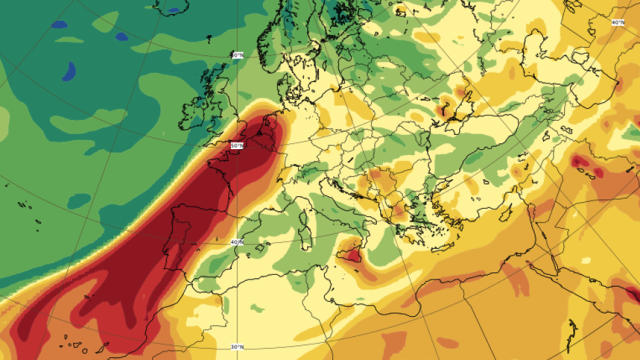The European Space Agency released fascinating imagery last week showing how the ash plume from the La Palma volcano eruption is charging westward across the Atlantic Ocean. The ash is passing through the atmosphere right at the tail end of peak hurricane season.
Considering that things have been (blessedly) quiet in the Atlantic for the past few weeks with regards to hurricanes, it makes sense to wonder about La Palma’s impact on hurricane season. While the ash is certainly something that can slow down hurricane season, we likely have other factors to blame, though.
Scientists at ESA’s Copernicus Atmosphere Monitoring Service have been tracking the ash plume since the volcano first started erupting in late September. Initially, the plumes of sulphur dioxide from the volcano travelled east from the Canary Islands to northern Africa and southern Europe, eventually getting to parts of northern and western Europe. Thanks to a change in wind direction in early October, though, the plume is now flowing roughly 5,000 miles (8,000 kilometers) across the Atlantic and over the Caribbean.
Since the directional shift, the Atlantic has also gone unseasonably quiet when it comes to hurricanes and tropical storms. There are a lot of factors that go into the formation of hurricanes. Not only do ocean waters need to be warm enough to feed the churning storm (which, thanks to climate change, is happening more and more often), but the air in the atmosphere also needs to be moist and unstable to allow the storm to grow. Any change in the atmospheric conditions–outside factors that make it drier or warmer — can influence how hurricanes form.
One notable example of this is dust from the Sahara desert travelling with winds all the way across the Atlantic and toward Mexico. This is actually a pretty regular occurrence and routinely impacts hurricane formation. The dust is accompanied by super dry air, which gets injected into the atmosphere and quiets down any precursors to hurricanes. CAMS actually noted that the arrival of Saharan dust to the Caribbean coincided with the volcano plumes reaching the islands, which resulted in poor air quality in Puerto Rico and other parts of the region in early October.
The role of ash, though, is less well known. Ash is an aerosol, a blanket term for tiny particles that can help clouds form. Salt from the ocean, dust, and manmade pollution are all considered aerosols as well. Dustin Grogan, who works in the Department of Atmospheric and Environmental Sciences at the University of Albany, said in an email that he wasn’t aware of any research linking volcanic ash to the development of hurricanes.
“In general, the sulphates from volcanic ash (or from wildfires) would help promote cloud development in convective systems, such as hurricanes, as they serve as seeds for cloud droplets,” he said. “There are, however, several studies that have investigated aerosol effects on hurricanes associated with dust, originating from the Saharan Desert.”
Grogan noted that since the plume has turned towards the Atlantic, “there has been only one storm that has shown potential to produce a hurricane over the Atlantic, and it did not develop,” although he cautioned that he hadn’t fully looked into all the links between the volcano and the stunted storm. He also said that the volcanic plume meeting up with the cloud of dust as they both move westward “may add complexity to teasing out the ash’s contribution on storm development.”
Brian McNoldy, a senior research associate at the Rosenstiel School of Marine and Atmospheric Science at the University of Miami, said in an email it was possible “the plume of aerosols from the volcano are fairly high up in the atmosphere and not getting ingested into any prospective disturbances (or hurricanes).”
The volcano is still erupting, and even though the plumes are expected to re-circulate back to Europe, hurricane season lasts until November 30. That means there could be more potential for storms, and more opportunities to see — if the winds start blowing the ash to the Atlantic — how the ash plays out.
“The end of the hurricane season is also fast approaching,” Grogan said. “So, we will have to wait and see if any other storms develop and interact with the ash.”
Other natural factors such as the recently developed La Niña could also play a role. The shift toward cooler ocean temperatures in the eastern tropical Pacific generally eases winds that can shred storms. That means ash and dust or not, there’s still ample time for hurricanes to spin up.
